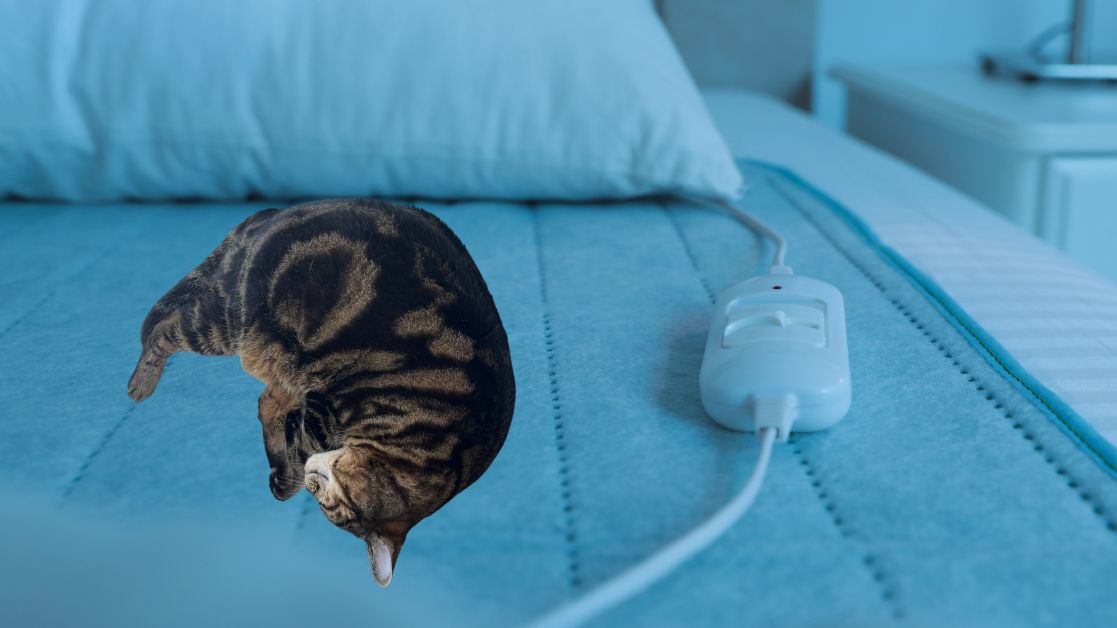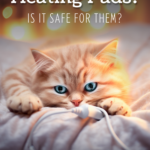QUICK ANSWER
Cat heating pads offer warmth and comfort, particularly in cold weather and for kittens. Heating pads can benefit cats with arthritis, in cold seasons, or during kitten care.
Use them cautiously by avoiding direct contact and limiting usage to 20-30 minutes.
Adding a protective layer like a blanket enhances safety.
Prioritize your cat’s safety, keeping a close watch during use. Striking a balance between warmth and caution is crucial for your cat’s well-being.
Cats are naturally drawn to warmth, and heating pads can be quite tempting. But, you might be wondering, is it safe for cats and kittens to use heating pads?
In general, cats tend to seek out warm spots around the house. If you pay attention to your cat’s favorite lounging spots, they’re likely in sunny areas and warm spots. This behavior can be traced back to their wild ancestors who thrived in desert climates.
Cats also maintain a higher internal body temperature than humans, at around 102 degrees Fahrenheit. This means they have to find ways to cope with heat loss more effectively.
What Are Heating Pads and Are They Safe to Use?
A cat heating pad is a small cushioned device that maintains your pet cat warm as it rests. These heating pads are appropriate for cats of all ages and at any time of year. Most cats will appreciate them more when the weather becomes cold.
Heating pads can be quite safe for cats and kittens, especially when set to a mild or warm temperature. However, it’s crucial to keep an eye on your furry friend when they’re using one.
Avoid letting your cat lay directly on the heating pad or exposing them to prolonged heat. Limiting the use to around 20 to 30 minutes is a good practice. Additionally, you can place a thick blanket or piece of fabric on top of a gently warmed heating pad as a protective buffer for added safety.
When Should Heating Pads be Used on Cats and Kittens?
Using heating pads or similar heat sources can be a great idea in several situations for cats and kittens.
Cats Suffering From Arthritis
Heat therapy can help arthritis-affected cats minimize discomfort, stiffness, and muscular spasms. Place a heating pad on your cat’s bed, set it to the lowest temperature, and let your cat rest on it for 20 to 30 minutes, covering it with a thin blanket.
Orphaned Kittens
If you are caring for orphaned kittens, it is critical that you supply them with a heat source in addition to their mother’s body heat.
Create a kitten-proof area with a heating pad set on low and a nice blanket covering it. Check up on the kittens frequently and monitor them while using the heating pad.
Winter Season
It is also preferable to use heating pads during the winter season. Cats seek warmth as the weather gets colder.
You can also provide a refuge for feral cats in your area. Put a heating pad in a warm covered box. Cut a small hole at the box’s end, insert a waterproof outdoor electrical cord, and sandwich a heating pad between a carpet square and a blanket.
Set it to a low setting and set a timer to turn it on at dark and off the next morning. Make sure it’s in a dry, covered area, such as a porch, covered patio, or storage shed.
Sick Cats
Heating pads are beneficial to sick cats because they supply the required warmth to the cat’s body, allowing him to be more comfortable. During the winter season, your cat will be more prone to disease.
When used indoors, heating pads can help your cat rest better and strengthen their immune system.
Human Heating Pad VS Pet Heating Pad
The heated cat pad provides mild heat that is comparable to the body temperature of a dog or cat. For a pet’s skin, regular human heating pads can become excessively hot for pets, potentially causing discomfort or anxiety.
Heating pads created specifically for pets can be used safely by cats. This is so that they can heat up to a cat’s body temperature, not above it. This minimizes the chance of your cat being overheated while keeping them warm and cozy.
Potential Risks of Heating Pads
Heating pads are relatively safe for cats, but you should be aware of the following potential risks:
Burns
Cats should spend no more than 15 to 20 minutes on a heating pad. If he spends more time sleeping or reclining on top of the heating pad, he may get his skin burned and suffer from internal organ damage.
Electrocution
While dogs are more likely to chew on things, a curious cat may see the heating pad’s cable as a pleasant treat or toy. Thus, the heating pad can be an electrocution hazard for both you and your cat.
Instead of purchasing an electric heating pad, you might want to look at other solutions. Otherwise, you’ll have to keep a tight eye on your cat and monitor the heating pad frequently for signs of damage, particularly along the cords.
Strangulation
Strangulation is another concern related to electric heating pads for cats. These devices are generally equipped with extensive cords that constitute a strangling risk. Your cat may play with the cord and perhaps strangle himself if it becomes twisted around him.
Intestinal Blockage
Cats might chew on the fabric covering heating pad wires and components, which can be hazardous if ingested. It can lead to choking or intestinal blockages as these materials pass through their digestive system.
To ensure your cat’s safety, consider safer heating alternatives and monitor your pet’s interactions with heating pads closely.
Bottom Line
Heating pads can be a valuable tool for keeping your cats and kittens warm and comfortable, especially in certain situations like arthritis, cold winters, or caring for orphaned kittens. Consider your cat’s typical behavior, particularly around electrical cables, before purchasing a heating pad. Always prioritize your furry friends’ safety and well-being.
If you choose to use a heating pad for your kitten or cat, do so responsibly, keeping a watchful eye on your cat to ensure they’re comfortable and safe. By striking the right balance between warmth and caution, you can provide your beloved feline companions with a cozy and secure environment, promoting their health and happiness.
Using heating pads is safe and beneficial for cats. Just ensure to monitor your feline pals while using the heating pads to prevent any accidents. To avoid any issues, make sure to check our list of cat heating blankets and pads.
RELATED: Are Cat Shock Collars Safe?






I feed 2 Feral cats and have an outdoor cat house for them, along with an electric outdoor waterproof heating pad for the house, it has 6 heat Levels, temps ranging from 86 degrees to 131 degrees. Level 3 is 104 degrees F – my question is: if the air temperature is in the single digits, will this heat Level be OK or should I raise it to Level 4, which is 114 degrees? I don’t want them to be cold, but I don’t want them to be harmed by laying on a heating pad all day that is too warm.